04 13, 2023
{{ content.title }}
{{ content.description }}
For two decades, California’s net energy metering (NEM) programs have made on-site solar photovoltaic (PV) systems lucrative for both residential and commercial customers. Across the country, net energy metering has proven to be a valuable solar incentive that increases solar payback and boosts ROI from installing solar. But for solar PV projects in California submitting interconnection applications after April 14, 2023, the economics change with the rollout of California’s third iteration of net energy metering – NEM 3.0.
Under NEM 3.0 – also known as the “Net Billing Tariff” – organizations who implement solar PV systems will receive lower average compensation for the solar energy they export to the grid when compared to NEM 2.0. With this change, many organizations think that NEM 3.0 will undercut the economics of new solar PV projects. However, they have another option to ensure they can maximize economic benefits under NEM 3.0 – integrating solar and energy storage.
A brief history of California net energy metering
California boasts the largest solar capacity installed by state, in part buoyed by net energy metering policies that created a favorable export rate for solar owners. As a policy tool, net energy metering has been used in California for more than 20 years to incentivize residential and commercial investments in on-site solar PV systems. As the name suggests, net energy metering allows households and organizations with on-site solar PV systems to export energy back to the grid and earn compensation at around the same rate as retail electricity. Exporting excess solar energy to the grid is very lucrative for organizations with on-site solar. It effectively means that they are only charged for the net energy they consume, regardless of their impacts to overall electricity grid at any given time.
Now that California has reached nearly 25 GW of solar on the grid, these solar levels have created new challenges, and other policy goals must be balanced with the continued adoption of on-site solar. In its latest review of the net energy metering program, the California Public Utilities Commission (CPUC) updated the program to ensure that it remains cost-effective and equitable by:
- Ensuring that customer-sited renewable distributed generation continues to grow sustainably
- Including alternatives designed for growth in disadvantaged communities
- Basing the tariff on the costs and benefits of eligible renewable electrical generation facilities
- Ensuring the tariff’s benefits to all customers and the electrical system approximately equals its costs
After months of deliberation and consultation, in late 2022, the CPUC finalized the state’s new “Net Billing Tariff.” More commonly known as NEM 3.0, this new tariff takes effect on April 15, 2023.
Net metering 2.0 vs. 3.0 – what’s changed?
Under NEM 2.0, customers were compensated for their exported energy at the retail rate minus some non-bypassable charges. The retail rate is based on time-of-use (TOU), with a higher rate charged at times of peak demand (on-peak) and a lower rate charged during times of low demand (off-peak). The non-bypassable charges are fees levied on utility bills to fund programs – like energy assistance for low-income households and energy efficiency – and sum up to around ¢2-3/kWh, depending on the utility. As a result, the value of solar exports varies according to the TOU schedule – i.e., it’s more profitable to export during peak demand hours.
While this structure provides simple and predictable rates for organizations with on-site solar, studies show that the value of the solar exports aligns differently from the times when they most benefit the local grid. To address this, the CPUC decoupled the export rates from the retail rate, to be determined based on the Avoided Cost Calculator (ACC) model. Therefore, organizations considering implementing solar PV systems will see their exported energy compensated at a new set of values based on estimated hourly utility avoided costs.
These avoided costs represent the underlying costs of delivering energy, as they vary by the hour and by the day. The figures below show how the export compensation rates compare between NEM 2.0 (black line) and NEM 3.0 (colored lines) throughout different winter, spring, and summer months.
NEM 2.0 vs. 3.0 export compensation rates
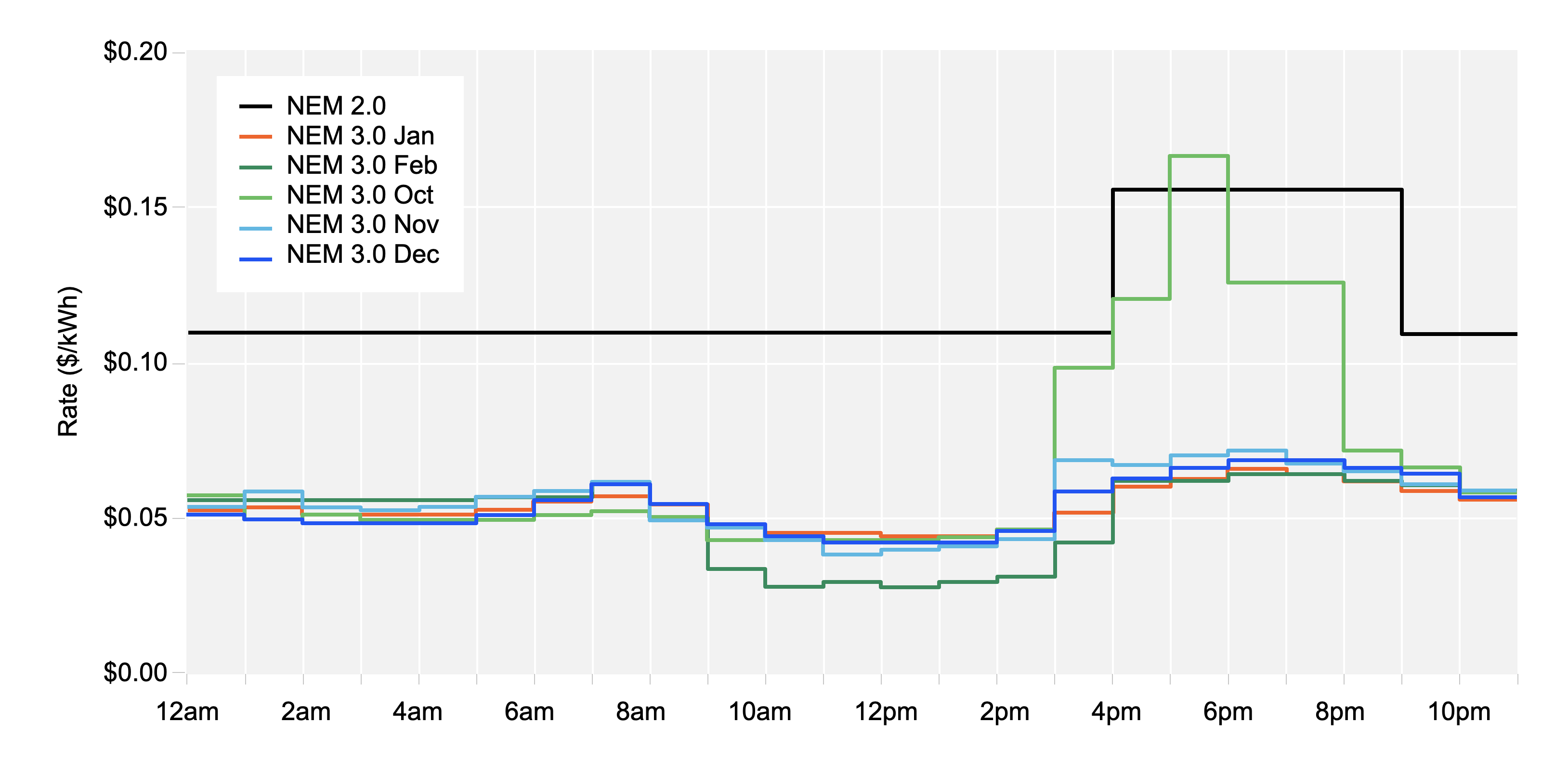
PG&E B-20 Secondary Winter Weekday 2023
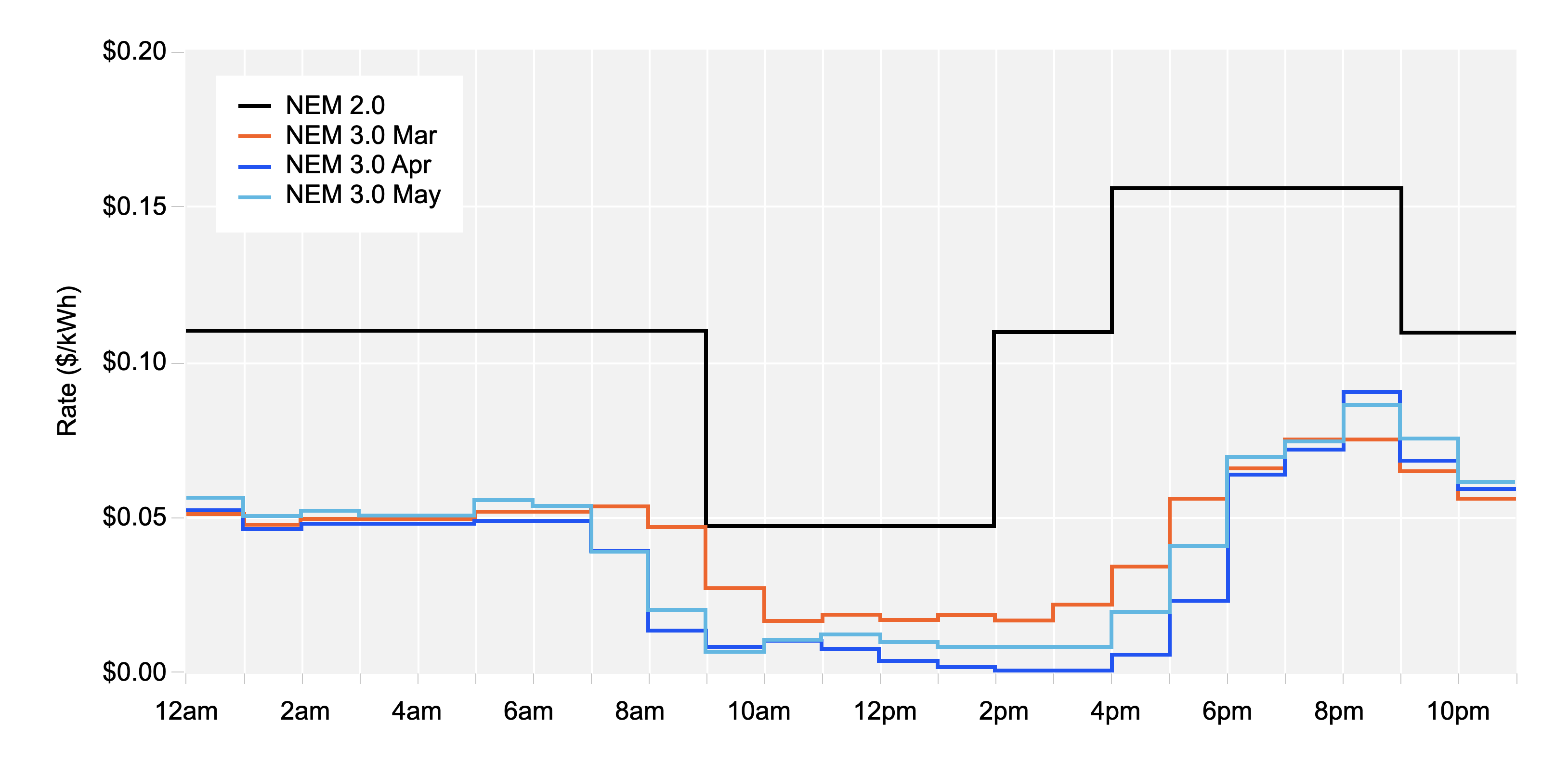
PG&E B-20 Secondary Spring Weekday 2023
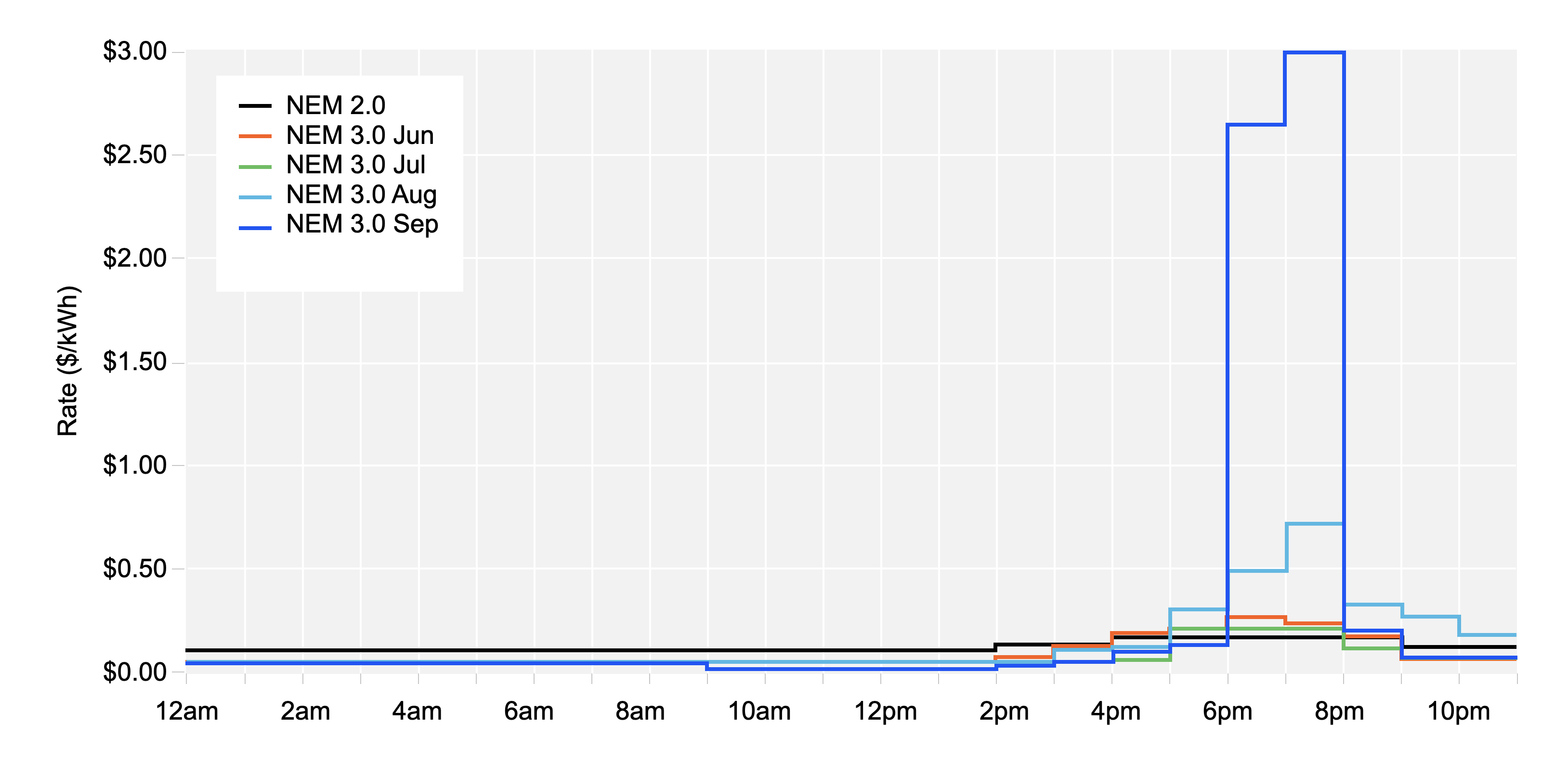
PG&E B-20 Secondary Summer Weekday 2023
Most of the time, the export rate under NEM 3.0 is generally lower than that under NEM 2.0. However, there are a handful of hours in which the export rate under NEM 3.0 is significantly higher, most notably in the summer evening hours. This higher rate incentivizes additional supply through increased solar exports in the summer days when electricity demand for air conditioning is high – and displaces California’s reliance on fossil-fuel peaker plants to meet the evening ramp.
Discover the differences between NEM 2.0 and NEM 3.0 in the table below.
NEM 2.0 vs. NEM 3.0

Comparing parameters
And there lies the value of NEM 3.0 – there are fewer profitable export hours than NEM 2.0, but those hours are more profitable if you can capture them. To find out how, watch our webinar below, where our analysts have compared the value of solar and solar paired with energy storage under different NEM configurations. We’ve also provided our analysis within this post.
The value of solar and solar + storage under NEM 3.0
Pairing your solar PV system with a battery energy storage system improves your project economics under NEM 3.0. The high export prices in the evening hours in the fall months signal the need to add more flexible, dispatchable resources like distributed energy storage. With an integrated solar and energy storage system, you can:
- Make your system a dispatchable asset to capture the value of exporting during high export compensation rate (ECR) hours
- Operate your system to conduct energy arbitrage and shave your peak demand to unlock more bill savings
- Maximize your solar energy consumption to capture your system’s sustainability value
Load profile on 2 summer days
How solar + storage creates additional value
To quantify these values, we assessed the project economics of seven commercial and industrial sites in California across different utility territories, tariff rates, and load shapes.
Evaluating 7 different sites
Explanation of the modeling inputs
We modeled each site’s project economics under four different NEM configurations: NEM 2.0 with and without battery exports, and NEM 3.0 with and without battery exports. The majority of solar + storage projects in California historically have not included battery exports. Renewable energy providers cited challenges gaining utility approval to enable battery exports. However, battery exports under NEM 3.0 are significantly more lucrative, and renewable energy providers will likely work with utilities to ensure they are able to take advantage of the high export rates in the summer months.
Our analysis led to 28 sets of results, which we will discuss below.
4 key takeaways from our NEM 2.0 vs. 3.0 analysis
First, as expected, NEM 3.0 reduces bill savings for solar PV-only projects. For the seven sites we modeled, this led to an 18% decrease in first-year bill savings.
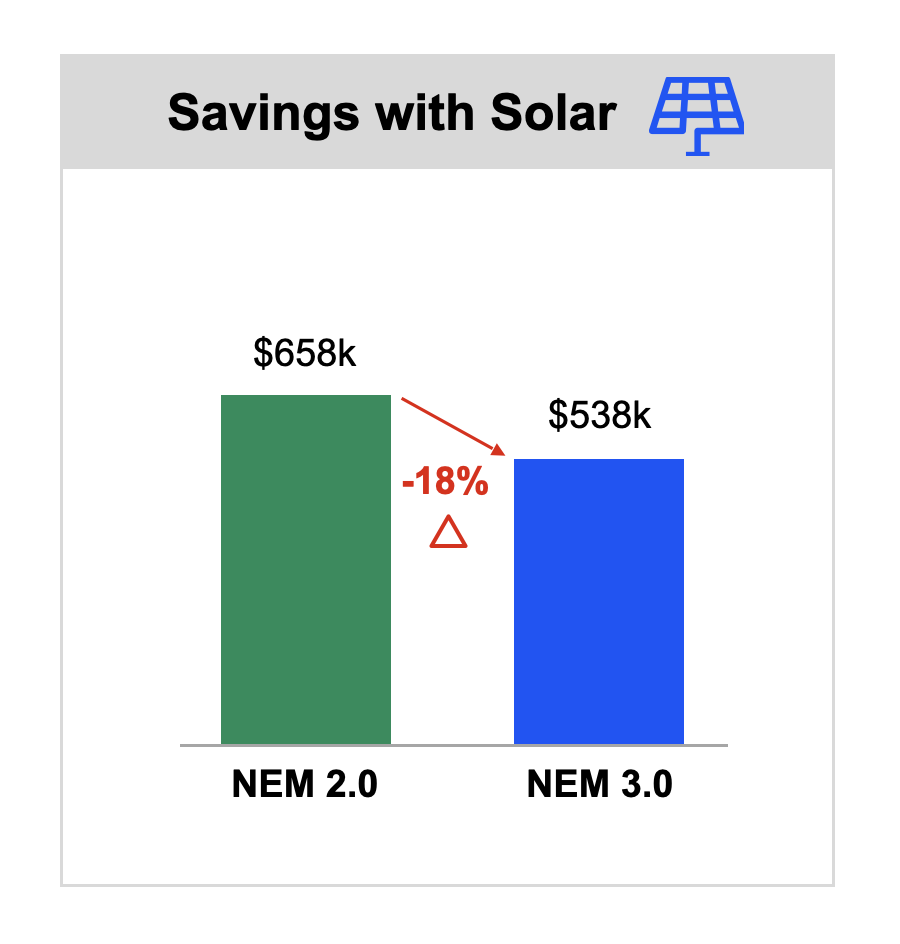
Second, NEM 3.0 economics improve when we pair solar and energy storage. This integrated system can capture the high export rates and enables further optimization (e.g., energy arbitrage, peak shaving).
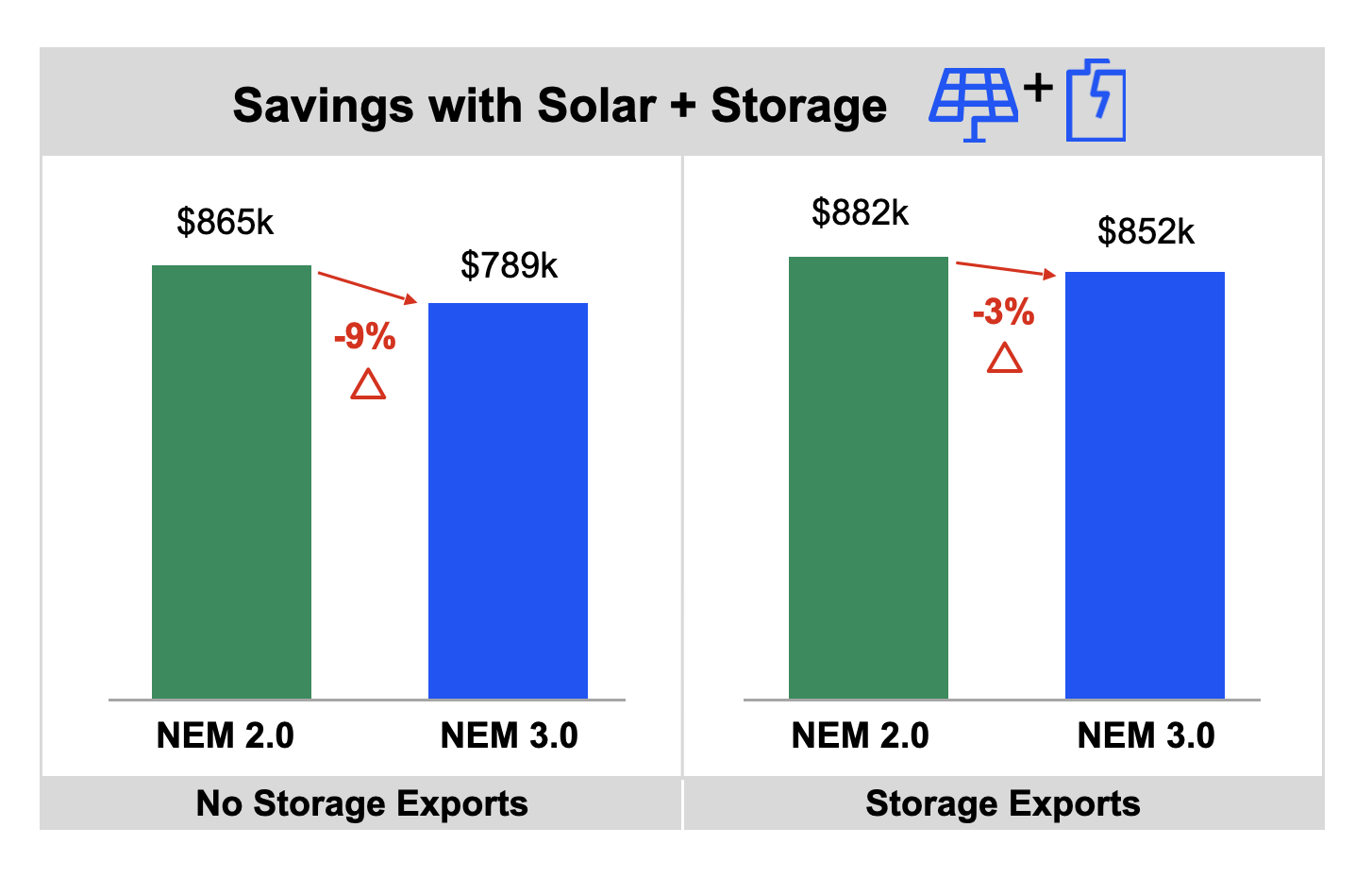
Third, looking at the relative contribution of solar vs. storage, we see that storage provides a higher percentage of total value under NEM 3.0. When storage exports are enabled, 37% of the total value comes from storage under NEM 3.0 vs. 25% under NEM 2.0.
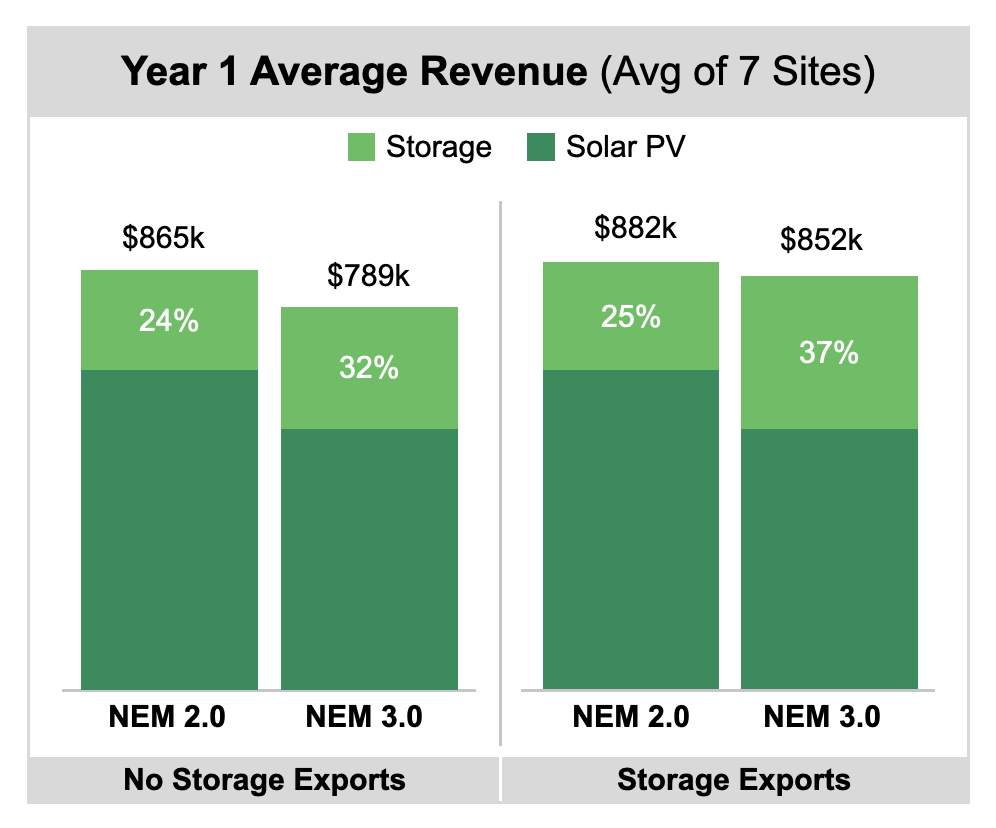
Finally, while a solar and energy storage system is, on average, less profitable under NEM 3.0 relative to NEM 2.0, there are many cases where a system is more profitable under NEM 3.0. The value of a particular solar or solar + storage system is highly dependent on the host facility’s load, which impacts your exports and overall flexible capacity. For example, the graph below shows that when a battery energy storage system can export, revenue under NEM 3.0 can exceed revenue under NEM 2.0. In fact, the majority (4/7) of the evaluated building types below showed increased savings under NEM 3.0.
What does NEM 3.0 mean for your organization?
The changed export rates under NEM 3.0 will undoubtedly change the California’s playbook for on-site solar and energy storage. While the economics of solar-only projects are worse under NEM 3.0, there are pockets of opportunity for strategically sited and sized solar and energy storage projects.
At Enel North America, we have an experienced Solutions Engineering team to help you optimally size your solar and energy storage systems, get on the right utility tariff, and maximize the value of your energy solutions. Our team of experts is ready to help you capture the most value from NEM 3.0. Reach out to us today to discuss the opportunities available to you and how our integrated solar and energy storage solutions can meet your specific energy requirements and sustainability goals.